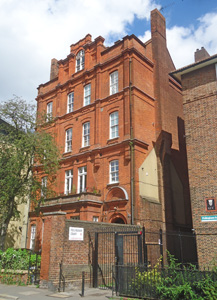Thomas Holyland was baptised on 15 May 1743 in Dunton Bassett, Leicestershire, the 5th child of John Holyland, the village baker, and his wife Mary.
In 1759, Thomas was bound as an apprentice to his first cousin Christopher Hollyland, who was an innkeeper in London. This apprenticeship broke down, and in 1763 Thomas was assigned to a new master. Ten years later he was admitted to the Worshipful Company of Vintners. In 1784 he was listed as a wine merchant on the Strand and by 1789 (possibly before), he was running Holyland’s Coffee House at 150, Strand, London (now the site of Gibraltar Government Office), “frequented by gentlemen belonging to the theatres and to Somerset Place.” (1)
He then expanded his business to include Holyland’s Family Hotel 5 minutes’ walk away, on the South-West corner of Cecil Street (a site now occupied by the Shell Mex building). This was advertised as “extensive premises --commanding a full view of the Thames and the Surrey hills”.
So far, so good – but in May 1801, Thomas was subject to a Commission for Lunacy.(2) Apparently “mental derangement had made its appearance” in 1799, following an attack of fever. Thomas was put under the care of Dr Perfect, at Malling, from where he escaped after two months; he was then confined to the house of Mills and Kay in Hoxton, from where he also escaped after six months. Thomas was said to be “jealous of his wife, accused her on all occasions, very unjustly, of profligate conduct, and threatened her life. She took every care of him. He was always outrageously mad when he took liquor, which he often did to excess”.(3)
After almost a full day of legal arguments, a jury found that Thomas had indeed been suffering from insanity on Dec 20 previously.
Dr Perfect was an early proponent of what was then the new art of “alienism” (or psychiatry) and had a reputation for humane treatment of the people in his care, which was often delivered in his own home.(4) The same could not be said for the asylum at Hoxton, where Thomas was confined. A
 |
| Hoxton House |
he desired that this man might not again be consigned to a dungeon, or chained to a bed, but his near relations ought to soothe his mind, and endeavour to bring him back to reason.
A year later, Thomas’ wife was running the business without Thomas, and advertising in the London papers that,
Mrs E Holyland begs leave to acquaint her friends and the public at large, that business is carrying on as usual, for the mutual benefit of Herself and Mr H, whose painful situation still unfortunately incapacitates him from taking an active part in the concern. (6)
After Thomas’s wife died in 1804 or 1805, the business was run on his behalf by his son in law, Richard Williams, who had married Thomas’s daughter Mary in 1794. In 1805, Thomas presented a petition to the Lord Chancellor stating that, since the death of his wife, he had “entirely recovered the use of his intellects” and “praying that an issue should be directed for the purpose of trying the facts”.(7) Thomas may well have been back in his home county of Leicestershire as he requested that the hearing take place at the Leicester assizes, so that the witnesses – more than 30 of them, who were based in the midlands- could attend. The report does not state the outcome of this petition, but does make it clear that Thomas was at liberty, although the previous judgement against him meant that he could be taken back into confinement whenever it pleased the commission. It was another 2 years before the court of chancery superceded the commission for lunacy taken out against him.
Thomas disposed of his businesses to his son in law and daughter on his release. In 1815, the coffee house was advertised as being “a superior house and the devotee who lodges there might go further and fare worse even if he trudged as far as Jerusalem”. (8) Richard Williams died in 1817 but his widow Mary carried on with the coffee house, having sold the hotel. Eventually the Holyland Hotel moved to Norfolk St in 1825 and the coffee house became a general clothing establishment.
Interestingly, details of Thomas’s marriage have not yet been clarified. In 1764 and 1767, Thomas and Eleanor Holyland of Fleur de Luce Court, off Fetter Lane, baptised 2 children, Mary and Eleanor, at St Dunstan in the West. There is no matching marriage to be found, but this would have been during Thomas’s apprenticeship, and apprentices weren’t supposed to get married! There is a marriage for a Thomas Holyland, batchelor, and Eleanor Dycus on 10 April 1794 at St Luke’s, Chelsea but the record for that marriage states that Thomas was of the parish of St Luke, which does not fit with his known residence and business in the Strand. Hellen Holyland – who may well, as Eleanor, have been Thomas’s wife – was buried at St Mary le Strand early in 1805. No other likely marriages have been identified for Thomas.
So what became of Thomas ultimately? I don’t know. Westminster rate books show a Thomas Holyland in Orchard Street North between 1811 -1815, but after that I cannot positively identify him. Did he go back to Leicestershire? Did he maintain “use of his intellects”? We can only hope that he never again found himself confined to a dungeon or chained to a bed.
1. The picture of London, for 1802, available on https://books.google.co.uk/books
2. Kentish Weekly Post or Canterbury Journal 12 May 1801
3. Morning Post 04 May 1801
4. https://en.wikipedia.org/wiki/William_Perfect
5. http://studymore.org.uk/hoxtonho.htm
6. Sun (London) 31 March 1802
7. Star (London) 29 July 1805
8. The Epicures Almanack, 1815
Comments
Post a Comment